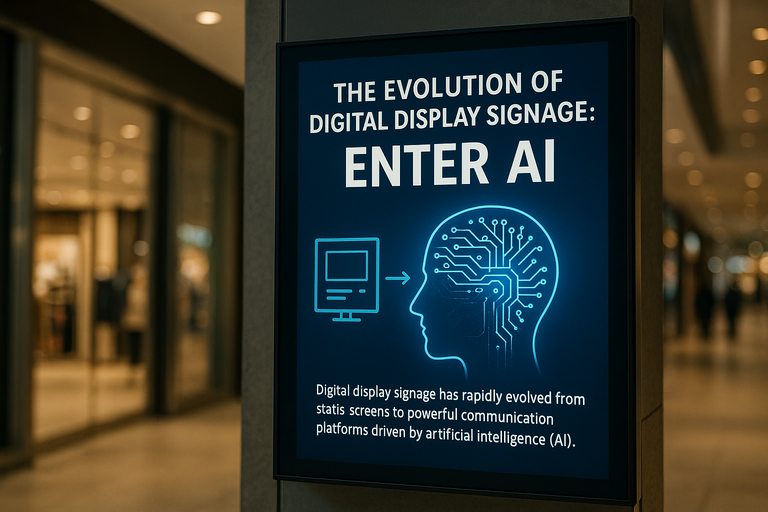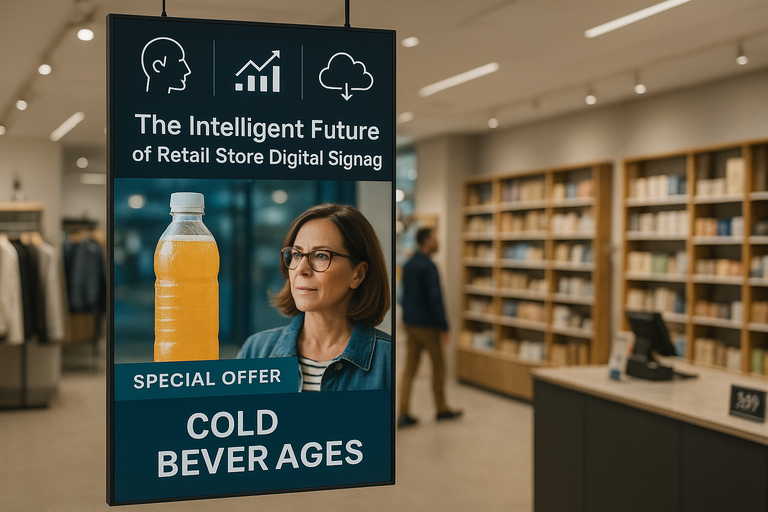In today’s rapidly evolving business landscape, the synergy of artificial intelligence (AI) and digital signage is transforming corporate communication. Intelligent AI-powered digital signage is now central to creating smarter workplaces, fostering real-time collaboration, and driving measurable business impact. As displays shift from static visuals to dynamic, adaptive platforms, AI unlocks new value for organisations across many sectors—especially within corporate Australia.
The Dawn of Corporate Digital Signage
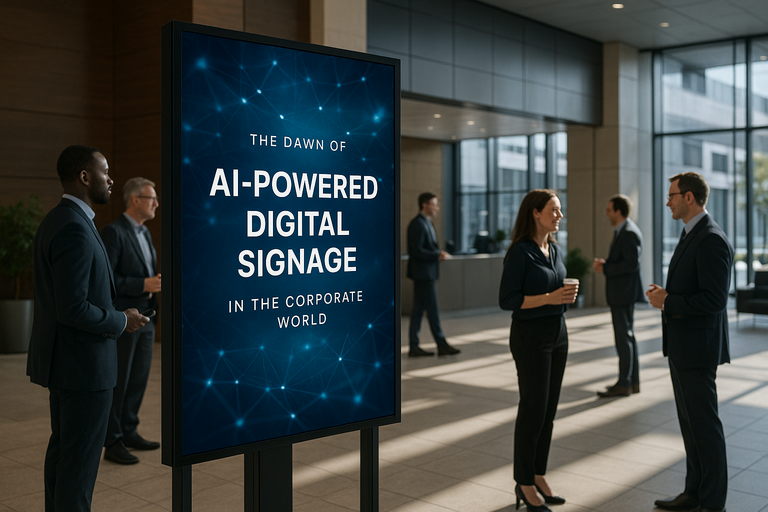
From Static Screens to Context-Aware Corporate Digital Signage
The evolution of digital signage displays has been significant. Early systems offered remote management and automated scheduling. However, content was often generic and impersonal. Today, AI-driven solutions change that. Every screen can be context-aware, responsive, and capable of learning from its environment.
Real-Time Personalisation for Corporate Digital Signage
AI integration allows digital signs to process anonymous demographic data, environmental cues, and even sentiment trends. As a result, content is tailored in real time. During emergencies, screens prioritise safety instructions. For navigation, wayfinding digital signage adapts to room usage and visitor flows. This convergence of machine learning and CMS tools moves organisations toward AI-Powered Digital Signage: 3.8x the Results with Half the Effort.
Stronger Internal Communications
This AI-driven shift directly improves internal communications. It reinforces brand culture and boosts operational efficiency. Instead of generic updates, businesses can segment audiences by role, department, or location. Then the right message appears at the right moment—KPI dashboards, meeting reminders, or milestone celebrations. A company-wide network becomes a living extension of your values.
Scalable Control with Cloud Intelligence
Local control paired with cloud intelligence ensures scalability. Whether you manage one office or a global enterprise, AI optimises content for each location. It coordinates data across sites to deliver a unified strategy that still feels bespoke.
Choosing the Right Platform
To realise this vision, select a platform with robust AI-powered features, effortless scheduling, and strong security. For example, Sign Inspire (see Features - Sign Inspire) helps teams visualise engagement hotspots and assess messaging effectiveness in near real time. The future of digital signage is intuitive, adaptive, and deeply integrated into corporate life.
According to Statista’s global digital signage market outlook, industry growth continues to accelerate, driven by AI innovation and data-led content strategies.
Emerging Corporate Digital Signage Use Cases
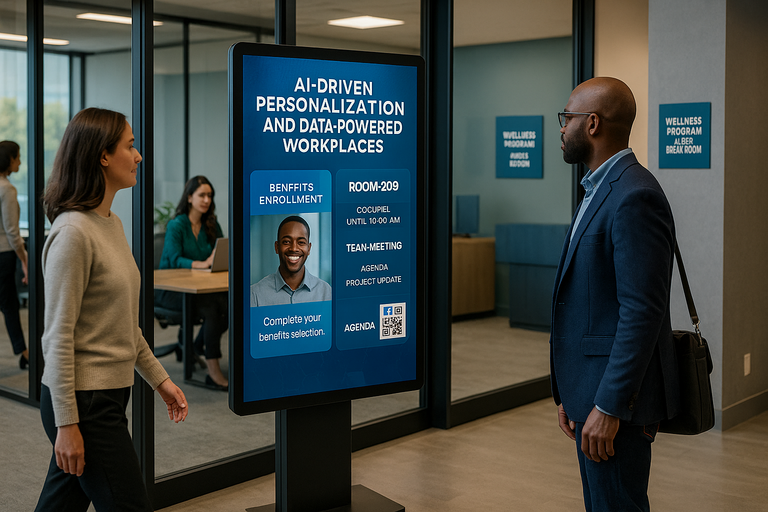
Targeted Internal Communications
With interactive digital signage now an intelligent touchpoint, AI unlocks precise audience targeting. By analysing traffic patterns and demographics, screens can display:
- Benefits enrolment prompts for newly onboarded employees.
- Wellness program highlights near break rooms.
- Compliance reminders when relevant teams are nearby.
Smarter Meeting and Visitor Journeys
In meeting spaces, AI-powered workplace displays integrate with room booking systems. They show occupancy, availability, and current agendas. For hybrid workforces, welcome screens adapt to arriving teams, greet VIPs by name (when opt-in applies), and provide QR codes for document sharing or feedback. Consequently, logistics become smoother and faster.
Live, Actionable Dashboards
Digital signs also serve as interactive analytical dashboards. On manufacturing floors or within sales teams, real-time visualisations track goals, safety stats, and wins. AI engines retrieve and organise just-in-time metrics. Thus, outdated whiteboards give way to data that drives action.
Well-Being and Culture
AI can detect shifts in engagement—via anonymous trends—and automatically display motivational content, mental health resources, or relaxation prompts. Therefore, corporate environments become more supportive and human-centric.
For additional inspiration, see the Services – Sign Inspire section and broader use cases. Restaurant-specific examples appear on the Digital Signage Restaurant Solutions page.
Specs That Matter for Corporate Digital Signage
Commercial vs Consumer Hardware
When selecting digital signage displays, commercial-grade LED digital signage outperforms consumer TVs. It is built for 24/7 use and diverse deployments—an advantage highlighted in any digital signage vs TV comparison.
Key Buying Criteria for Corporate Digital Signage
- Brightness (nits): Choose 500–700 nits for bright lobbies. For outdoor areas, consider 2,500+ nits.
- Durability & Hours: Look for 16–24/7 operation, robust components, and good cooling.
- Orientation: Confirm landscape and portrait support with proper ventilation.
- Lifespan & Warranty: Commercial digital signage monitors often last 8–12 years with 3–5 year warranties.
- Connectivity & Integration: Prefer HDMI, DisplayPort, Ethernet/Wi-Fi, 5G readiness, and APIs for calendar, visitor, and comms systems.
- CMS: Use a robust, cloud CMS for remote scheduling and multi-site control—e.g., AI-powered programs from Sign Inspire.
Industry Trends for Corporate Digital Signage
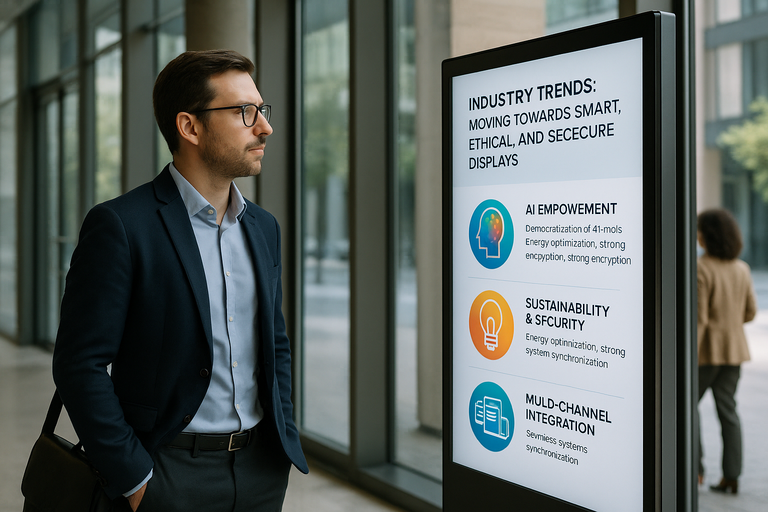
Democratisation of AI Tools
Advanced capabilities—heatmaps, real-time sentiment cues, and predictive scheduling—are now accessible to everyday content managers. Therefore, teams can make evidence-based decisions and improve ROI across deployments.
Sustainability and Security
Intelligent digital signage uses AI to reduce energy use, dimming screens during off-peak hours. Meanwhile, networks must protect sensitive data through encryption, authentication, and privacy-by-design. Australian organisations should consult the Australian Privacy Principles (APPs) for compliance guidance.
Multi-Channel Integration
Digital signage synchronises with room reservation apps, visitor platforms, directories, and mobile tools. As a result, screens and devices reinforce messages across channels without extra effort.
Responsible AI Stewardship
Leading providers embed ethical frameworks into AI-powered signage. They anonymise data, enable opt-in, and explain analytics use. For deeper context, see AI’s Ethical Crossroads.
Privacy & Compliance in Corporate Digital Signage
Regulatory Alignment
In Australia, organisations must follow the APPs under the Privacy Act 1988. Internationally, GDPR and CCPA may also apply.
Practical Safeguards
- Anonymisation: Prefer anonymous, aggregated analytics over PII.
- Consent & Transparency: Use clear opt-ins and visible notices when personal data may be captured.
- Data Retention: Keep data only as long as necessary, then delete it securely.
- Security: Encrypt data, restrict access, and audit systems—including the digital signage player and CMS.
- Bias Mitigation: Review models regularly to prevent discriminatory outcomes.
Real-World Examples of Corporate Digital Signage
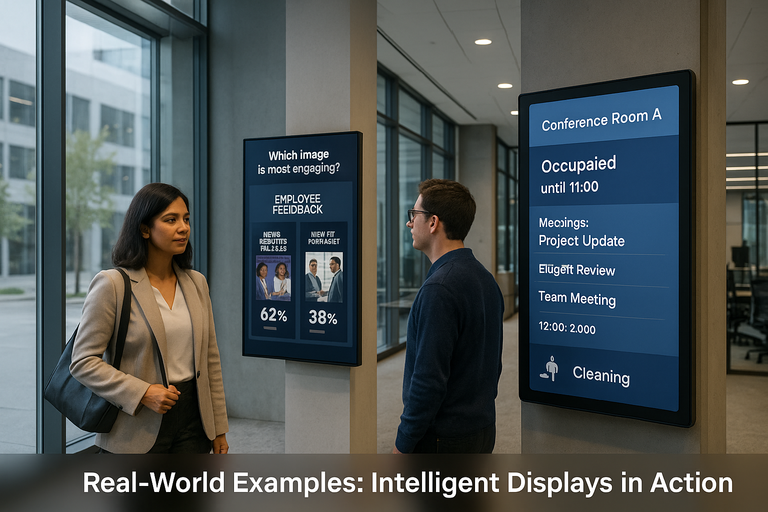
Meeting Room Management
A multinational consulting firm uses AI signage to manage rooms across continents. Integrated calendars and access systems display schedules, announce changes, and notify cleaning when rooms are vacant. Consequently, admins save hours each week—often with 99.9% uptime.
Employee Engagement & HR
A financial services company measures attention metrics for internal campaigns. When a benefits program launches, screens adapt messaging to the formats that drive longer dwell times. HR gains rapid feedback and improves comprehension.
AI-Assisted Content Creation
Comms teams use AI tools to generate banners, infographics, and multilingual variants. Rollouts become faster. Quality increases. Design costs can drop by up to 40%.
Explore more success stories under Find the Best Digital Signage Solutions. For restaurant-focused AI use cases, visit Digital Signage Restaurant Solutions.
Implementation Best Practices for Corporate Digital Signage

Define Clear Objectives
Start with measurable goals: improve engagement, streamline visitor flows, or cut admin effort. For example, aim to reduce check-in time by 20% in six months using in-store digital display kiosks.
Pilot Then Scale
Run a pilot in high-visibility areas—reception or break rooms. Expand once benefits are proven. Choose a provider that offers flexible installation and deep IT integrations.
Measure What Matters
Work with your vendor to set KPIs such as dwell time, engagement rate, and QR-driven intranet clicks. Review results regularly. Then iterate with A/B tests or POS tie-ins to sharpen ROI for your digital signage program.
Align Stakeholders & Train Teams
Bring IT and comms together early. Establish security, governance, and workflows upfront. Train content teams on AI tools so they can innovate without relying on agencies. Your checklist should cover hardware, CMS setup, analytics sensors, and operations.
Stay Informed
Finally, track industry changes. Subscribe to the Digital Signage Archives for trends, case studies, and regulatory updates.
Future of Corporate Digital Signage
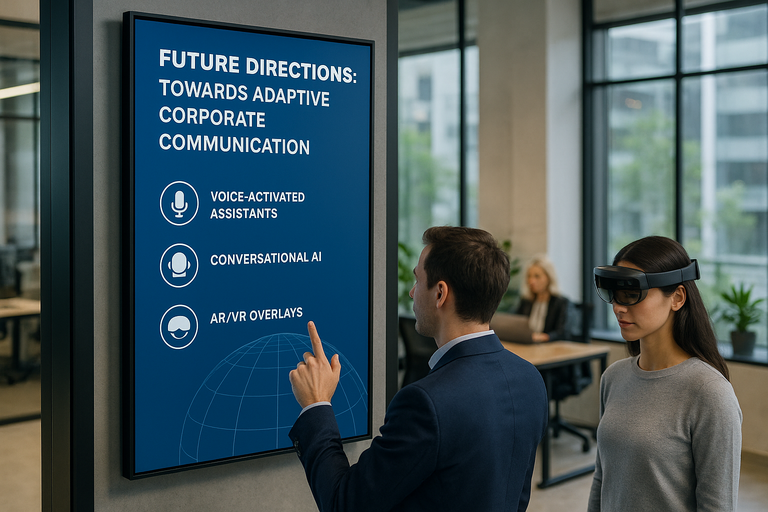
What’s Next
- Conversational AI: Voice assistants enable hands-free interactions and faster HR support. See The Conversational Screen.
- Immersive Overlays: AR/VR enhances training, onboarding, and product demos.
- Unified Workspaces: Digital signage supports hybrid work and space optimisation.
- Edge AI: On-device intelligence enables faster, private, and contextual content delivery.
- Generative AI: Automated creation of banners and multilingual content. See AI Image Generation.
- Robotics: Affordable humanoids act as guides or brand ambassadors alongside digital signage.
Companies investing now in corporate digital signage will gain an edge. They will engage talent, delight visitors, and streamline operations—setting new benchmarks for adaptable, employee-centric workplaces.
Frequently Asked Questions about Corporate Digital Signage
Q: How does AI enhance corporate digital signage beyond traditional displays?
AI enables real-time customisation based on audience and context. It replaces static content with relevant, personalised messages. Therefore, engagement and efficiency both improve.
Q: What are the key benefits for businesses?
Expect better internal communications, higher engagement, smarter room management, dynamic wayfinding, and stronger analytics. Together, these outcomes create a modern and efficient corporate environment.
Q: Is data privacy a concern?
Reputable solutions prioritise privacy-by-design. They favour anonymised analytics and comply with Australia’s APPs, plus GDPR and CCPA where relevant. See guidance from the Office of the Australian Information Commissioner.
Q: What technical specs should I look for?
Choose high brightness for visibility, commercial-grade durability for 24/7 operation, both orientations, long lifespan, and a robust CMS. Seamless integrations with IT systems are also essential.
Q: How can we measure ROI?
Track dwell time, engagement, QR scans, and admin time saved. You can also integrate analytics with sales or HR systems for tangible impact.

